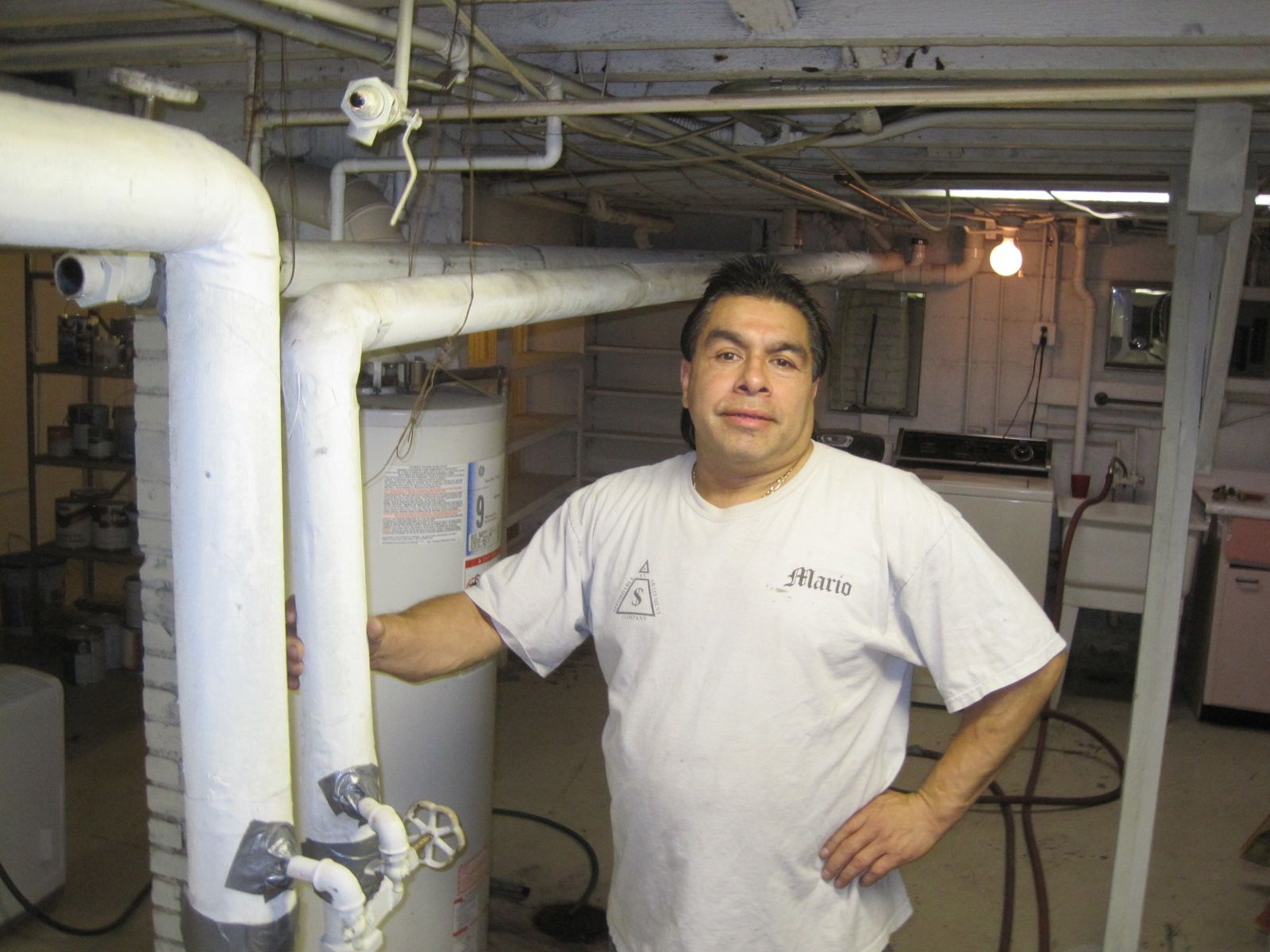Michelangelo once explained that David had always been in that block of marble, he merely removed the parts of the stone that was not David.
I don’t pretend that This Odd House contains a world treasure to be discovered within, but the concept of increasing value by removing things is an interesting topic I’d like to explore. I am currently in the process of paying good money to remove things that someone, at some time, paid good money to install. On my list now or soon: a kitchen, a furnace, water heater, insulated pipes, chimney, buckthorn hedge, garage.

Mario, of Affordable Abatement, next to the “mains”, the large, asbestos wrapped heating pipes that will be contained and removed from the basement.
Today’s “progress” on This Odd House was to remove the asbestos clad pipes feeding the radiators from the old boiler. Mario, from Affordable Abatement Company, set up his equipment, cut the boiler into pieces so he could lug it out of the basement, and then proceeded to wrap, slice, and cut the large asbestos covered, gravity fed heating pipes, and haul them out too. Today I can walk the length of the basement without stooping!
One could argue that the things I am removing carried a perfectly good functional value. The boiler was reliable, the pipes and radiators did their job. Removing them decreases the value of the house. And in one sense it is true, today I have a house in Minnesota that has no provision for heat!
So after paying for the boiler and asbestos removal, is my house worth more today, or less? When I pay for the buckthorn removal, or the demolition of the garage (with fractured concrete pad and swaying roofline), have I increased my equity?
One of the founders of ecological economics, Herman Daly, promotes the concept of a “steady state economy” where sustainability, not growth, is the goal. One of his observations is that we define our Gross Domestic Product, GDP, to include the economic activity to demolish, discard, dispose, and otherwise remove previously manufactured and functioning items from our environment. Why do we include the value of creating the item in the GDP if we also include the cost of scrapping it? From a resource standpoint, this can only misguide us.
More locally, when I demolish the chimney, does this add to the value of the house? Should I add this expense to my home equity? Could I turn around and sell it for this additional amount? These are complicated questions, especially since “the market value” of a house is simply what someone is willing to pay. Whether the house has a chimney or not does not seem to be one of the factors in buyer appraisals (it certainly did not enter into mine).
Ah, but if I can put a skylight in the place where the chimney had been, maybe then I can parlay that removal expense into something worth more. Certainly I would enjoy it. And maybe that is what matters right now. I’m not trying to reveal David in a rough block of stone, I’m just wanting a nice place to live.

I meant to comment on your previous post related to removing, or keeping your chimney. One option you did not mention having explored was the option of performing the repair yourself. I do not know how extensive the damage is, but it seems to me that you probably could repair it yourself for far less than professional repair or removal. Of course, the removal plus skylight addition is “brilliant”, in my opinion. Just random thoughts. – John
If you can step away from the financial aspects of fixing up this house, there is another way to look at the value of this renovation. By modernizing and beautifying this property, you are making a great contribution to the future of your neighborhood and city. People who are willing to renovate old properties help keep cities vital and desirable. So you are improving the quality of life for those around you as well as for yourself. You can’t easily measure that in dollars!
Thanks for the wonderful encouragement Lynn. I will think back on it every time I find one more thing that is broken or needs replacement and I tally its expense. “Renovating an old house: $100k; contributing to the health and vitality of your neighborhood– priceless!”
Oh, and when you replace that boiler, where, exactly, will the necessary vent go if you remove the chimney?
A little extra hot air to warm the house, of course.
Pingback: Seasonal conditioning / conditional seasoning | This Odd House